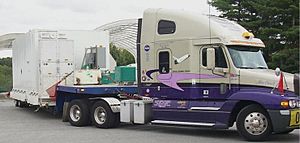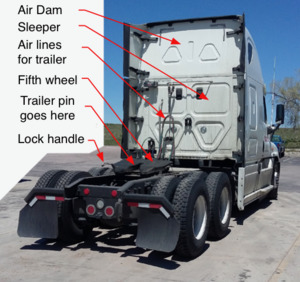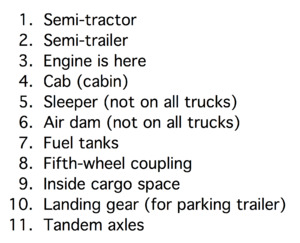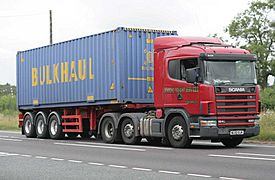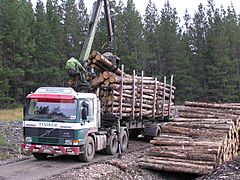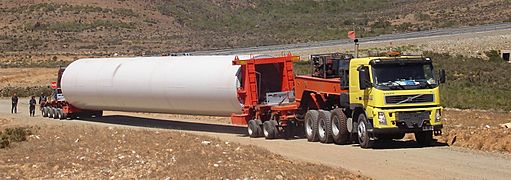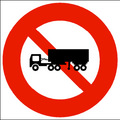Semi-trailer truck facts for kids
A semi-trailer truck is a large vehicle used to carry goods. People also call it a semi, tractor-trailer, big rig, or eighteen-wheeler. In the United Kingdom and Ireland, it's known as an articulated lorry. This vehicle has two main parts: a towing engine, called a tractor, and a semi-trailer that carries the freight.
Contents
How a Semi-Truck Works
The front part of the truck, called the semi-tractor, does not carry any cargo itself. It's like a powerful engine on wheels. The front end of the semi-trailer rests on the tractor. This means the tractor pulls the trailer and also carries some of its weight.
Semi-tractors and their drivers are expensive. However, the trailers are much cheaper. This setup is very useful because one tractor can pull many different trailers. Drivers don't have to wait for a trailer to be loaded or unloaded. They can simply drop off one trailer and pick up another. This also allows them to pull various types of trailers, depending on what needs to be moved.
Truck Differences Around the World
Laws for semi-trucks vary in different countries. The biggest difference between trucks in Europe (EU), the United Kingdom (UK), and the United States (US) is their length. Most trucks weigh about the same. US trucks are slightly lighter than those in the EU and UK. Their width and height are generally similar everywhere.
In larger countries, trucks can be longer. This allows them to carry more cargo. Longer semi-tractors also drive more smoothly at higher speeds. Most US trucks are "conventional" types. This means the engine is under a hood in front of the driver's cab. In the US, shorter trucks weigh less. The weight must be spread out over a long length. This is very important when trucks cross bridges. Longer trucks mean fewer trucks fit on a bridge at once. Also, their axles are spaced far apart, which helps distribute the weight.
In the UK and EU, roads are often narrower and have more turns. Because of this, trucks need to be shorter. Most trucks there are "cab-over-engine" (COE) models. In these trucks, the driver sits right over the engine. The front of the cab is flat. Shorter trucks can still carry heavy loads. Their trailers might have three axles under the load. Their short semi-tractors usually have two axles. These trucks can carry the same weight as longer ones. They take up less space and can turn corners better.
Countries also differ in which side of the road they drive on. This also affects where the driver sits in the truck. The UK is a main country where people drive on the right-hand side of the road. Most countries that used to be British colonies also drive on the right. This means the driver sits on the right side of the vehicle. Most EU countries and others drive on the left side of the road. This means the driver sits on the left. When building a truck, it's easy to make it for either left-hand or right-hand drive. For example, Australia builds US-style trucks like Mack and International, but they are made for right-hand drive.
Different Kinds of Trailers
Semi-trailers come in many types, just like regular trucks. Since trailers are less expensive than tractors, they can be designed for special uses. For example, large and heavy shipping containers need special trailers. Some countries have specific laws for these. Skeleton frame trailers are built just to carry these containers.
Long semi-trailers are used for carrying logs. In the UK and EU, some logs are smaller. Their trailers are designed to hold two or three logs. They often have a crane to help load the logs. In the US, "lowboys" are trailers where the load sits very close to the road. These are used to carry large construction machines. Special trailers can also be built for extremely big loads. In Australia, "road-trains" are very long trucks that can pull up to four trailers at once!
Images for kids
See also
 In Spanish: Camión articulado para niños
In Spanish: Camión articulado para niños


